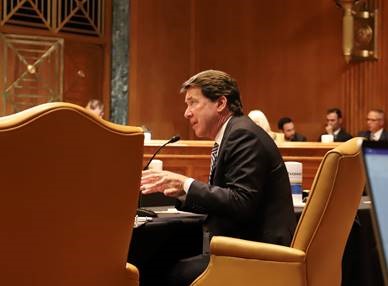WASHINGTON—United States Senator Bill Hagerty (R-TN), a member of the Senate Appropriations Committee, extended an invitation during today’s hearing to U.S. Secretary of Energy Jennifer Granholm to visit Oak Ridge National Laboratory in Tennessee.
Hagerty highlighted the economic impact, innovation, and research Oak Ridge National Lab has both in the state of Tennessee and across the nation. Hagerty also mentioned the Lab will unveil the world’s first exascale computer, which will be the fastest supercomputer in the world, and invited Granholm to join him and other members of the state’s congressional delegation at the Lab.
“I’m very pleased that Oak Ridge is going to unveil this year an exascale computer called “Frontier”, which will be the fastest in the world, right in my home state of Tennessee,” Hagerty said. “We’ve talked about this before, Madam Secretary, but I’d like to join with my colleagues, Senator Blackburn and Congressman Fleischmann, to invite you to come and visit us at Oak Ridge National Lab, to see what’s happening there and to deepen our working relationships so we can continue to make these advancements. I hope you’ll be able to find time in your schedule soon to join.”
In response to Hagerty, Granholm accepted the invitation to see the unveiling of the exsacale computer and learn more about the Oak Ridge complex.
Hagerty also asked the Secretary what role the Department of Energy plans to take in recreating innovation hubs like the Oak Ridge Corridor in a way that will support economic growth in underserved communities.
“It’s something I think that we should market as an innovation hub. We have such incredible technologies.” Hagerty said.
Secretary Granholm responded by saying she has been working with lab directors to support the STEM pipeline and technology transfer from the labs to adjacent communities.
“A lot of these labs are looking to develop that STEM pipeline and really want to be in the community to talk about the importance of science, technology, engineering, and math, both starting in high school through college, partnering with local colleges and certainly partnering with the universities that are already there. So pipeline issues are one. Economic development, technology transfer from the labs to perhaps sort of technology hubs that are related to the lab, but using products that could be commercialized outside of the lab,” Granholm said. “We have a fantastic new leader of our Office of Technology Transfer, who is really focused on what are those opportunities to create, perhaps incubators, either inside the lab structure or outside, in an adjacency to be able to create a whole cluster of dynamic innovation, creating an innovation hub in an area that may be seen as often cloistered because it’s inside of perhaps fencing, etc.”

*Click photo above or here to watch*